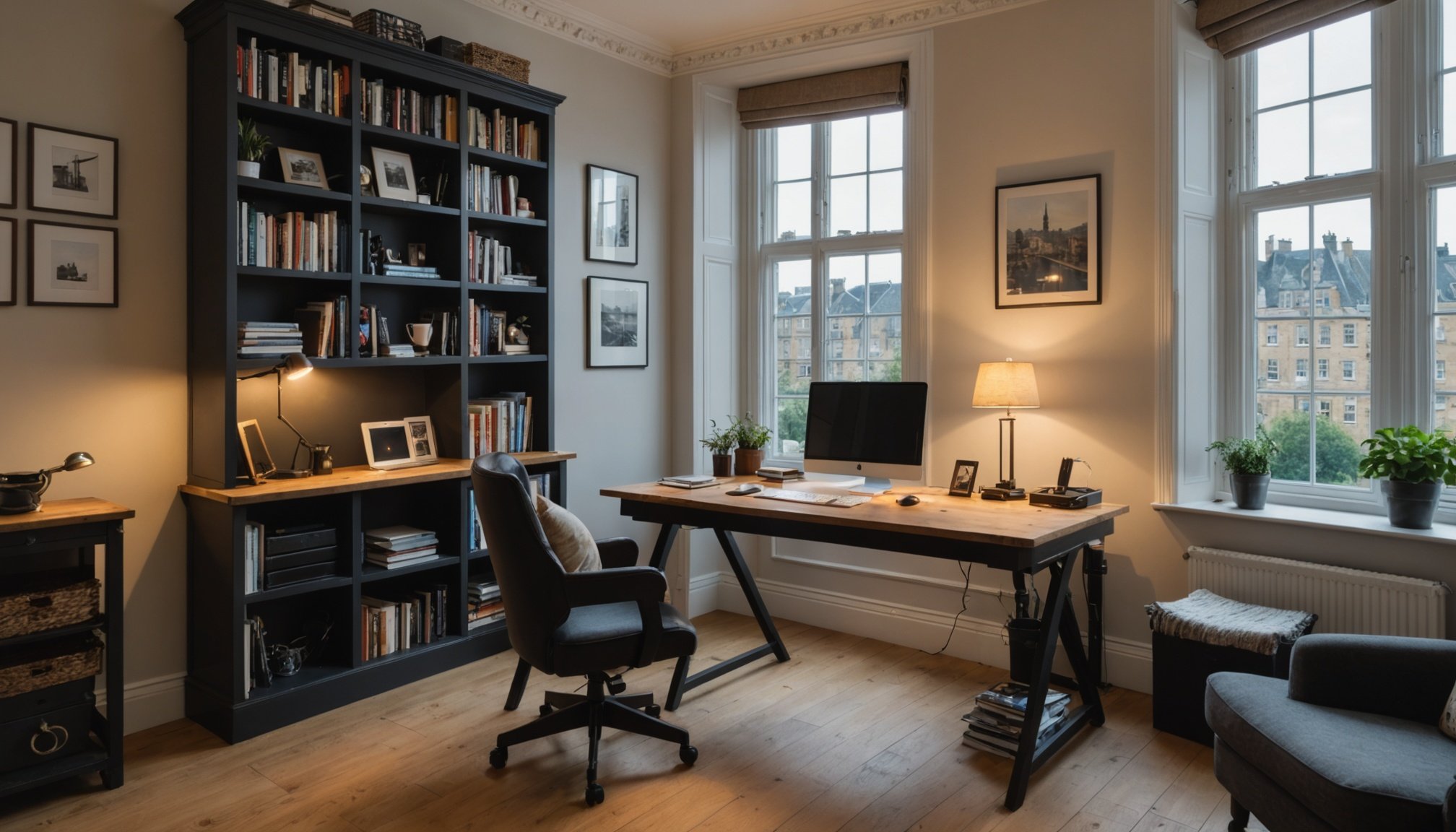Creating an ergonomic home office in your Edinburgh apartment is essential for boosting productivity and ensuring comfort. With the right setup, you can transform any small space into a functional work environment. Consider factors like desk height, seating arrangement, and lighting to enhance both efficiency and well-being. Explore innovative solutions to optimize your workspace, making your cozy apartment a perfect blend of style and function. Design the ideal setup that caters to your needs and promotes a healthier work-life balance.
Understanding Ergonomics in a Home Office
Ergonomics is the science of designing workspaces that foster comfort and efficiency, crucial for anyone setting up a home office. The goal is to create an environment that supports productivity while minimising physical strain. In a well-designed home office, ergonomics can significantly impact both comfort and work output.
A lire en complément : Selecting the Ideal Greenhouse for Windy Coastal Conditions in the UK: A Complete Guide
Importance of Ergonomics
Incorporating ergonomic principles into your home office design can prevent discomfort and health issues such as back pain or repetitive strain injuries. This is especially vital for those spending long hours at a desk. A well-ergonomically designed space promotes better posture, reduces fatigue, and enhances overall work efficiency.
Ergonomic Principles for Small Spaces
When working with limited space, it's essential to be strategic about your home office design. Start by selecting a chair that supports your lower back and allows your feet to rest flat on the floor. Position your monitor at eye level to avoid neck strain. Additionally, ensure your keyboard and mouse are within easy reach to prevent overstretching. By focusing on these ergonomic elements, even a small space can become a comfortable and productive work environment.
A lire en complément : Discover modern open-joint weo cladding for stylish spaces
Space Optimization Techniques
When dealing with small living spaces, optimizing your home office setup is essential. Start by decluttering and organizing your workspace. Remove unnecessary items and keep only what you need. This not only creates a tidy environment but also enhances focus.
Utilize vertical space by installing shelves or wall-mounted storage units. This frees up valuable desk space and keeps essentials within reach. Consider multifunctional furniture, like a desk with built-in storage or a chair that doubles as a file cabinet. These pieces help maximize your available area without sacrificing functionality.
Creating distinct work zones in limited areas can be challenging, but it's achievable. Use room dividers or rugs to visually separate your work area from the rest of your living space. This distinction helps maintain a work-life balance, even in compact environments.
By implementing these space optimization strategies, you can transform even the smallest of spaces into an efficient and organized home office.
Selecting Ergonomic Furniture
Choosing the right ergonomic furniture is essential for creating a comfortable and efficient home office.
Key Features of Ergonomic Chairs
When selecting chairs, look for features like lumbar support, adjustable height, and seat depth. These elements ensure your chair supports your spine's natural curve and helps maintain good posture. A chair with armrests can reduce shoulder strain, while a swivel base allows easy movement, enhancing overall comfort.
Desks for Small Spaces
For small spaces, consider compact desks with built-in storage. Look for designs with adjustable heights to accommodate different tasks or postures. Wall-mounted desks or foldable options can also save space and provide flexibility. Prioritising a desk that fits your space without compromising on functionality is key.
Importance of Adjustable Furniture
Adjustable furniture is crucial for adaptability in a dynamic workspace. It allows you to tailor your setup to your needs, promoting better ergonomics. Height-adjustable desks and chairs enable you to switch between sitting and standing, reducing prolonged static postures. This flexibility can significantly enhance your comfort and productivity throughout the day.
Effective Lighting Solutions
A well-lit home office is essential for boosting productivity and maintaining focus. Natural light is a prime resource, so position your desk near windows to harness its benefits. This not only reduces eye strain but also enhances mood and energy levels. If natural light is limited, consider using light-coloured curtains or blinds to amplify what is available.
Types of Artificial Lighting
Artificial lighting plays a crucial role in areas lacking natural light. Use a combination of ambient, task, and accent lighting to create a balanced environment. LED bulbs are energy-efficient and provide consistent illumination, making them ideal for home office lighting. Task lights, such as adjustable desk lamps, focus light where it's needed most, aiding concentration on specific tasks.
Placement Tips for Optimal Lighting
In small spaces, strategic light placement is key. Position task lights to avoid shadows on your work area. Wall-mounted or under-shelf lighting can save space while offering targeted illumination. Ensure overhead lighting complements natural light, preventing glare on screens. By thoughtfully arranging your lighting setup, you can create an inviting and efficient workspace that supports your professional endeavours.
Enhancing Comfort with Accessories
Enhancing your home office with office accessories can significantly boost both comfort and productivity. Incorporating wrist supports and footrests can prevent strain during long work hours. Wrist supports help maintain a neutral hand position, reducing the risk of repetitive strain injuries. Meanwhile, footrests promote better posture by supporting your legs and feet, minimising lower back discomfort.
Adding plants and decor to your workspace can create a calming environment. Plants not only improve air quality but also reduce stress and enhance focus. Choose low-maintenance options like succulents or peace lilies to keep your space green without too much effort.
To improve workflow, consider integrating tech accessories such as ergonomic keyboards and wireless chargers. An ergonomic keyboard can reduce wrist strain, while wireless chargers keep your devices powered without cluttering your desk. These small additions can make a significant impact on your daily work experience, ensuring a more comfortable and efficient environment.
Incorporating Technology for Efficiency
Integrating home office technology can significantly enhance your work efficiency. Essential productivity tools include high-speed internet, a reliable computer, and a quality webcam for virtual meetings. These form the backbone of a successful remote work setup.
Essential Tech Tools
Investing in smart solutions like noise-cancelling headphones can improve focus by reducing distractions. A multi-port docking station simplifies connectivity for multiple devices, streamlining your workspace.
Software and Apps
Utilise software and apps designed to boost productivity. Project management tools like Trello or Asana help organise tasks and deadlines efficiently. Communication platforms such as Slack or Microsoft Teams facilitate seamless collaboration with colleagues.
Smart Home Devices
Incorporating smart home devices can create a more integrated work environment. Smart speakers can manage schedules and reminders through voice commands, while smart lighting can adjust brightness to suit different tasks. These technologies not only enhance productivity but also contribute to a more comfortable and adaptive workspace.
Finding Inspiration: Local Retailers and Resources
Creating a home office in Edinburgh can be an exciting journey, especially when you explore the variety of local retailers offering ergonomic furniture. Stores like John Lewis and IKEA provide a wide range of home office supplies, from adjustable chairs to compact desks, catering to different styles and needs. Visiting these stores allows you to test furniture and envision how each piece might fit into your space.
Beyond physical stores, online platforms offer a wealth of design inspiration and purchasing options. Websites like Pinterest and Houzz showcase innovative home office setups, helping you discover new ideas and trends. These resources also link you to products available from local and international sellers, providing a broader selection of ergonomic solutions.
Engaging with the community through workshops or events in Edinburgh can also be beneficial. Local events often focus on sustainable design and offer practical tips for setting up an efficient workspace. These gatherings provide opportunities to learn from experts and connect with others who share your interest in creating a comfortable and productive home office.
Practical Solutions for Common Challenges
Setting up a home office comes with its own set of challenges, especially in small living spaces. Addressing distractions is crucial for maintaining productivity. Consider noise-cancelling headphones to block out background noise, or use a white noise machine to create a consistent sound environment. Allocating a specific area solely for work can also help minimise interruptions.
Time management is another hurdle for remote workers. Implementing strategies such as the Pomodoro Technique, which involves working in focused sprints followed by short breaks, can enhance efficiency. Utilising digital tools like calendars and task managers aids in organising daily tasks and deadlines.
Maintaining work-life balance in a home office setting requires clear boundaries. Set specific work hours and communicate them to household members. This helps in distinguishing professional time from personal time. Additionally, creating a routine that includes regular breaks and physical activity can prevent burnout and improve overall well-being. By adopting these productivity tips, you can effectively navigate the common challenges of working from home, ensuring a more structured and balanced work environment.











